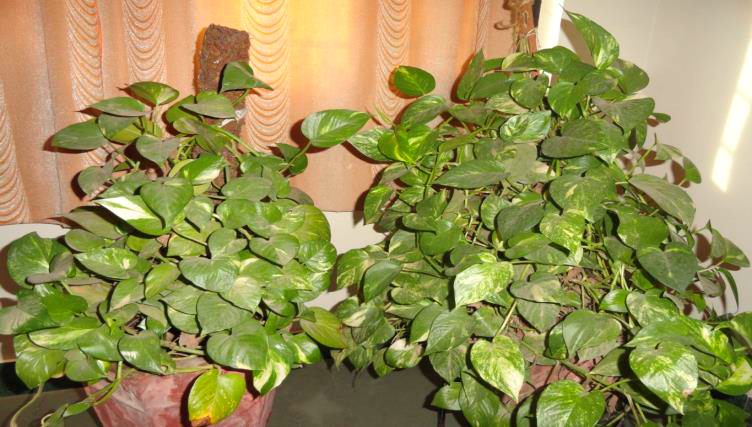
Scientist
Seeing is believing, it is said. The following articles document, in some detail, the positive results of Agnihotra and Agnihotra ash on growth of plants, plant resistance to disease and pests, shelf life and other parameters of quality, taste and quantity.
It is difficult to underestimate the potential such data has for a world beset by climate influences causing difficulties to agriculture.
By Dr. Ulrich Berk (Germany)
In the previous article we saw that Agnihotra Ash helps seeds to germinate better. The same result we get when seeds are kept for germination in a room where Agnihotra is performed regularly.
These are very simple experiments which everybody can easily perform at home also.
We again suggest that you try yourself – and then please also send us photos of your results.
Definitely the germination stage is very important for the life of plants. But unless we are just interested in sprouts it is important to see how plants grow further until they are harvested. Will plants also grow faster in the later stages, will there be a stronger resistance against diseases and pests, etc.? What about the quantity, the quality of the produce, the nutritional value, the shelf life?
There were a lot of observations and reports from people performing Agnihotra in their gardens as well as from farmers who performed Agnihotra in their fields and used Agnihotra Ash for irrigation and for preparing different sprays.
One relatively simple experiment was done in Fergusson College, Pune, India.
Two plants were maintained providing same amount of water, light and other environmental conditions. One was kept in a room where Agnihotra was performed and another was kept in another room where Agnihotra was not performed. See the difference in growth of these two plants:
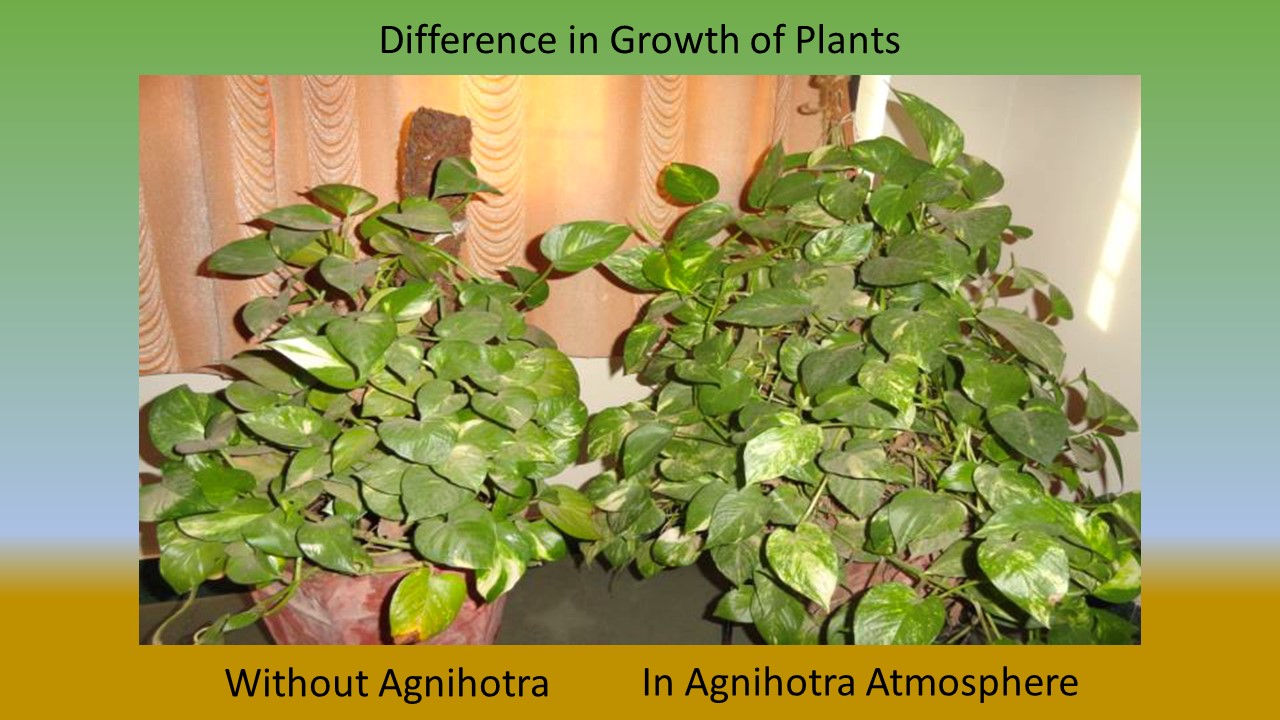
Although the experiment was not done under ideal conditions, still the different in growth of these two plants is obvious. Ideally for such an experiment there should be a difference of three kilometres – but in this case the two plants were grown in two different rooms of the same building, so also the first plant got definitely SOME of the Agnihotra effect.
This is just one example. More systematic research has been done by Dr. Selvaraj at the Institute of Commercial Horticulture, Tamil Nadu Agricultural University, Ooty, India. Yield, quality of the produce, and disease resistance were examined, comparing:
- Organic farming system
- Organic farming system + Agnihotra
- Conventional farming
- Absolute control
Following some of the results.
Effect of organic farming on growth and yield of Rose cv. Passion
| Treatments |
Fresh flower wt/ plant (g) |
Stalk length (cm) |
Flower diameter (cm) |
No. of flowers/ plant/year |
Shelf life of flowers (days) |
| Organic |
19.54 |
85.59 |
6.81 |
26.54 |
14 |
| Organic +Agnihotra |
21.34 |
88.98 |
7.54 |
28.80 |
16 |
| Conventional |
12.98 |
75.98 |
5.54 |
16.70 |
3 |
| Absolute Control |
8.65 |
67.23 |
3.54 |
12.65 |
1.5 |
| CD at 5% |
0.85 |
2.95 |
0.55 |
1.25 |
– |
Organic plus Agnihotra gave best results in all the parameters which were checked.
Flowers are normally grown in greenhouses, and because of high humidity fungal diseases are quite common. A study showed that Agnihotra can control one common fungal disease, powdery mildew (characteristic are white powdery spots on the leaves and stems).
Effect of organic farming on the incidence of Powdery mildew of Rose cv. Passion
| Treatments |
Powdery mildew (Spaerotheca pannosa) (%) |
| Organic |
4.4 |
| Organic +Agnihotra |
2.9 |
| Conventional |
12.3 |
| Control |
25.9 |
Another experiment was done on potatoes. Yield and the occurrence of late blight were examined. (The disease late blight affects mainly potatoes and tomatoes – and which led to the Irish potato famine of the 1840s, two million people died or emigrated from Ireland then!).
Effect of Agnihotra on pest complex of potato cv. Kufri jyoti
| Treatments |
Late blight (%) |
Yield (t/ha) |
| 90 days after planting |
| Organic |
45 |
8.4 |
| Organic +Agnihotra |
11 |
9.6 |
| Conventional |
65 |
4.2 |
| Absolute Control |
80 |
2.5 |
Other salient findings were:
- Organic farming with Agnihotra in Carnation recorded higher performance for plant height (95.43 cm), stalk length (93.24 cm), flower diameter (7.76 cm), number of flowers/plant/year (9.78), shelf life (14.43 days) compared to other treatments.
- In Carnation, Organic farming with Agnihotra showed higher disease resistance.
- In Gerbera, Organic farming with Agnihotra recorded higher performance for number of flowers 20, shelf life 16 days.
- In Gerbera, Organic farming with Agnihotra showed higher disease resistance for leaf spot, fusarium wilt.
- Among the four treatments Organic farming with Agnihotra in Potato recorded higher performance for yield (9.6 t/ha) and showed increased disease resistance.
These were quite impressive results of the first systematic study on yield, health, disease resistance, and shelf life of plants.
In the next article we will look into
- the underlying mechanisms – how does Agnihotra achieve these positive effects, and
- how to make use of these effects on farm level.
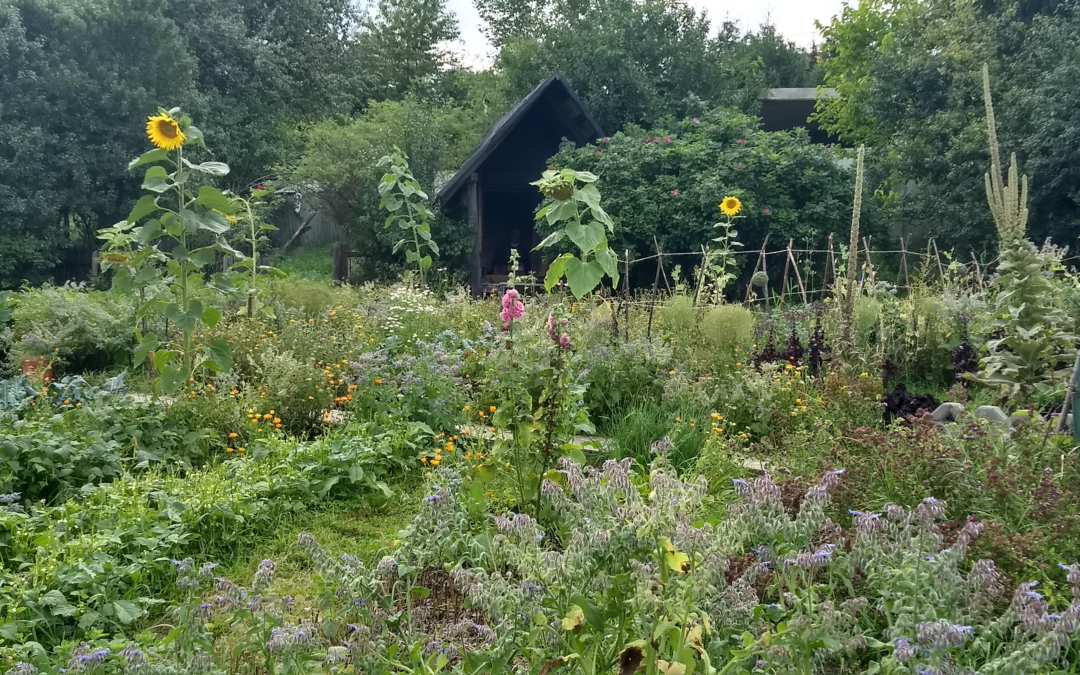
Scientist
By Dr. Ulrick Berk (Germany)
In the last issue we have discussed the effects of Agnihotra and Agnihotra Ash on the growth and disease resistence of plants – both under lab conditions and in a greenhouse.
But what are the effects in field conditions? The first systematic study on Homa Organic Farming was done in the Agricultural University in Palampur, Himachal Pradesh (a Northern State in India, at the edge of the Himalaya mountains).
Interesting how this research project started.
In 2006, Karin Heschl and Bruce Johnson, both experts on Homa Organic Farming who live in India, gave presentations at a conference on organic farming. After Karin’s presentation in which she mentioned considerable increase in the yield of mangoes in Homa Therapy atmosphere, one participant of the conference, Dr. DS Rathore, at that time Vice-Chancellor of the Palampur Agricultural University, expressed his protest afterwards– saying that it is just impossible that burning cow dung and ghee and uttering some simple mantras could bring about such effects.
Another senior agricultural scientist, Dr. RK Pathak, saw this and talked to Dr. Rathore – saying that is is unscientific to just claim the Homa method cannot work. A scientific approach would be to set up an experiment and show that the method does not work.
Dr. Rathore agreed, so they were setting up a small Homa Organic Farm on the land of the university. In 2007 Reiner Sczypior, a Homa volunteer from Austria who then stayed in India, set up the resonance system. On that farm during several years a lot of research was conducted. Soon it became clear that the original aim – showing that Homa methods do not work – could not be achieved. On the contrary, they got many good results.
They studied the effect of organic nutrients including Agnihotra Ash on crop productivity and soil health.
Medicinal plants like lemongrass, wild marigold, and aloe vera were chosen.
With lemongrass, there was a significant increase in the yield attributes viz plant height, number of leaves and plant spread and ultimately the yield of lemongrass increased with the addition of organics over the control.
Highest biological yield (7833 kg per hectare) was obtained in the treatment with organic manure + Agnihotra Ash + sowing according to the moon calendar, while lowest yield (2833 kg per hectare) was obtained in control + not following the moon calendar. Second best treatments was that using organic manure + Agnihotra Ash, but not following the moon calendar.
Also the oil content was best in treatments with Agnihotra Ash – up to seven times higher than control!
Similar results were with wild marigold and with aloe vera. The authors sum up their findings as follows:
“To sum up, it has been clearly demonstrated in this experiment that in lemon grass, wild marigold and aloe vera Agnihotra Ash was significantly superior to other organic treatments.“
The second part of their research was about soil health, a very important factor also for future production (and declining soil health is a big problem worldwide because of conventional farming).
Following the results they got regarding soil health:
- Homa environment inhibited growth of harmful bacteria like Fusarium solani, F.oxysporum, Rhizoctonia solani, Sclerotinia sclerotiorum, Sclerotium rolfsii, Phoma medicaginis and Alternaria brassicae;
- Maximum inhibition ranged (29-42%) recorded in Agnihotra hut followed by Tryambakam hut (8-32).
- Homa environment had adverse impact on appearance and population build up of pests like tomato fruit and shoot borer and semi loper;
- Homa ash possessed deterrent capabilities for management of these insects as compared to untreated tomato plants.
- Applications of as dust in soil at transplanting & further supplementation as drench at regular 15 days interval was effective in management of these insects.
- Effects of Agnihotra Ash on the growth of soil borne pathogens and bio agents indicated that all organisms were inhibited by Agnihotra Ash;
- Aerial micro flora count showed interesting observations:
- Bacterial counts in room where Agnihotra was performed got reduced significantly.
- In room with only fire did not show any significant change in microbial (bacterial, fungal, and actinomycetes) counts! This shows that control of harmful bacteria is actually the effect of Agnihotra performed properly – just having a fire does not have these effects.
- In total of 70 beneficial bacterial isolates, 18 isolates selected as phosphate solubilizers.
- 18 showed IAA production in range of 0.4-15.6 μg/ mL
- (IAA – Indole Acetic Acid – production is a major property of rhizosphere bacteria that stimulate and facilitate plant growth.)
- 7 isolates showed siderophore production in range of 3-14 activity diameters. (Siderophores make iron available to plants.)
- 12 bacterial isolates showed Ammonia production.
- Isolates isolated during and after the Agnihotra were found to show a variety of PGPR traits. (PGPR: Plant Growth Promoting Rhizobacteria.)
- These appear attractive towards development of microbial inoculants and enrichment of various organic manures.
These results made it to the front page of the Journal “Indian Express“. “Bhasm“.

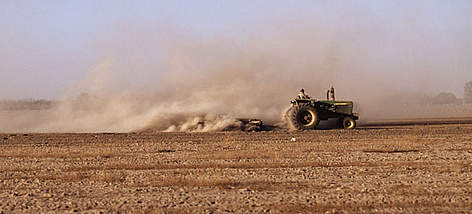
Scientist
By Dr. Ulrich Berk (Germany)
In the last article we talked about the experiments on Homa Farming done at Palampur Agricultural University, Himachal Pradesh, Northern India. The experiments showed increased yields, better disease resistance, and better quality of the produce.
The second part of their research was about soil health, a very important factor for future production.
More research was done on the effects of Homa Farming on soil health at Dharwad Agricultural University, Karnataka, Southern India. Four M.Sc. theses brought some interesting results. But before we are discussing these results (in the next article), let us first look deeper into the situation of our topsoil which is of utmost importance for the future of mankind.
A Sanskrit text written in around 1500 BC noted, “Upon this handful of soil our survival depends. Husband it and it will grow our food, our fuel, and our shelter and surround us with beauty.
Abuse it and the soil will collapse and die, taking humanity with it.”
(Quoted from: George Monbiot, Ploughing On Regardless, The Guardian, 25th March 2015
Thus abuse of soil mentioned as a possibility 3500 years as developed into a likely scenario now as we can see from recent reports from FAO, the Food and Agriculture Organization of the United Nations from two years ago.
An article in Scientific American makes it very clear that we live in kind of emergency situation, see the following article:
ROME (Thomson Reuters Foundation) – Generating three centimeters of top soil takes 1,000 years, and if current rates of degradation continue all of the world’s top soil could be gone within 60 years, a senior UN official said on Friday.
About a third of the world’s soil has already been degraded, Maria-Helena Semedo of the Food and Agriculture Organization (FAO) told a forum marking World Soil Day.
The causes of soil destruction include chemical-heavy farming techniques, deforestation which increases erosion, and global warming. The earth under our feet is too often ignored by policymakers, experts said.
“Soils are the basis of life,” said Semedo, FAO’s deputy director general of natural resources. “Ninety five percent of our food comes from the soil.”
Unless new approaches are adopted, the global amount of arable and productive land per person in 2050 will be only a quarter of the level in 1960, the FAO reported, due to growing populations and soil degradation.
Soils play a key role in absorbing carbon and filtering water, the FAO reported. Soil destruction creates a vicious cycle, in which less carbon is stored, the world gets hotter, and the land is further degraded.
“We are losing 30 soccer fields of soil every minute, mostly due to intensive farming,” Volkert Engelsman, an activist with the International Federation of Organic Agriculture Movements told the forum at the FAO’s headquarters in Rome.
“Organic (farming) may not be the only solution but it’s the single best (option) I can think of.”
(http://www.scientificamerican.com/article/only-60-years-of-farming-left-if-soil-degradation-continues)
This article advocates organic farming, definitely the first step we have to take. But as pollution of soil has gone so far, that will not be enough. Homa Therapy techniques have to be applied to restore soil helth, as the following article written by Shree Vasant Paranjpe shows:
HOW HOMA FARMING WORKS
Vasant Paranjpe
The soil, water, atmosphere, subsoil water are all polluted by the metallic, nonmetallic and gaseous toxicants of different types.
The soil in large areas of forest is nearly dead.
THE SOIL NEEDS TO BE REJUVENATED FIRST BY HOMA THERAPY.
In the rejuvenated soil different types of microorganisms, starting from the level of viruses, bacteria, fungi, algae, thrive.
Thus, a healthy micro-flora and micro-fauna is created.
This gives rise to a micro environment or micro-system which is comparatively less toxic to the growing plants.
The soil which has now become a living soil because of the presence of micro organisms has all the chemical components useful for life in the form of carbon, hydrogen and oxygen. According to modern theory, these three together form life in the form of bacteria. We have e.g. nitrogen fixing bacteria, also bacteria working on phosphorus content of soil
After the creation of such micro environment, creatures like earthworms thrive. They eat the soil, digest it and again replenish the soil.
It has been found that when Agnihotra ash is added to normal soil it increases the water soluble phosphate content of the soil and the nutrients are absorbed readily by the root hair of the plant.
Absorption of mega nutrients like Nitrogen, Phosphorus, Potash, because of small cells and active transport is helped by Homa atmosphere.
We have to tell the people this is how Homa farming works.
When you perform Agnihotra and YAJNYA or other HOMAS in a garden, an atmosphere is created that is conducive to growing and therefore attracts the nutrients, insects, microorganisms and animals that would be happy and thrive in that environment.
This, of course, is because nature is so wonderful, it automatically benefits the soil and the plant, and the plant thrives.
Same thing happens when you put the ash or use Agnihotra ash water but it works mere for the plants individually – by putting the ash around the individual plants or in the beds or spraying the plants, those elements that are best for that plant are attracted to it and it thrives.
Of course, we have to use basic operations of farming like weeding, organic composting, spraying with Agnihotra Ash solution, etc.
PRACTICE OF HOMA, HOWEVER, IS THE KEY.
These are clear guidelines for sustainable farming practices Shree Vasant gives. The article was written in 2008 or little earlier.
Good that in the meantime quite some research has been done some which confirms by means of modern science that Homa techniques really work well to restore soil health. This research work was mainly done at Dharwad Agricultural University, Karnataka, South India. We will have a closer look at the results in the next article.

Scientist
By Dr. Ulrich Berk (Germany)
In the last article we quoted reports of FAO (the Food and Agriculture Organization of the United Nations ) saying that farming only 60 years of farming would be left if conventional farming would continue like today.
Also we quoted Shree Vasant Paranjpe stating that the soil has to be rejuvinated first by Homa Therapy, thus creating a healthy micro-flora and micro-fauna.
This is the claim based on Vedic Knowledge.
To which extent could this claim be validated by modern agricultural sciences?
A lot of research work was done on the effects of Homa Farming on soil health at Dharwad Agricultural University, Karnataka, Southern India under the guidance of Dr. Pramod Basarkar. Four M.Sc. theses had the subject of Homa Farming – one each concentrated on studying growth, yield, disease resistance, occurence of pests, and effect on soil parameters.
Crops planted were soybeans, cabbage, tomato, and Okra (ladies’ fingers, a vegetable quite popular in Asian and African countries), one thesis each concentrating on one crop.
Results were very good showing increase in yield, better quality of the produce etc. Today we want to just look at the effect of Homa Farming on soil quality, soil health.
There were considerable improvements – although all these four studies were only carried out for one season! Would be interesting to see how the soil improves even further if Homa Farming would continue for a couple of years.
The four studies examined nutrient content and biological properties of soil, mainly beneficial microorganisms. But did not go into physical properties like soil texture and structure, pore space, permeability, water holding capacity, etc.).
Soil nutrients: normally there is a distincton made between macronutrients and micronutrients. Macronutrients are nutrients which are required in large quantities for plant growth. The primary macronutrients are N, P, K – Nitrogen, Phosphorus, and Potassium.
Micronutrients are of same importance for plant growth as macronutrients – only they are needed in smaller quantities.
Microorganisms: beneficial bacteria and fungi help to decompose organic matter in soil, fix nitrogen from the atmosphere, solubilise phosphorus, etc., and thus make nutrients available to plants. A soil without such microorganisms is dead – not really a soil in proper sense.
Actinomycetes have characteristics of both bacteria and fungi. Their role in soil is mainly to break down organic matter difficult to degrade.
Soil dehydrogenases are used as an indicator of the activity of soil microorganisms, also they play an important role in the biological oxidation of soil organic matter
Soil phosphatase activity plays a fundamental role in the transformation of P from soil organic matter into a forms available to plants.
Following the change of soil parameters, especially soil microbial count and content of macro- and micronutrients, compared with control without Homa.
(These studies examined up to 18 different treatment combinations, like soil application of Agnihotra Ash OR soil application of Homa Biosol. Here we do not want to got into these fine details – as in Homa Farming we use BOTH Agnihotra Ash (as well as other Homa ashes) and Homa Biosol.)
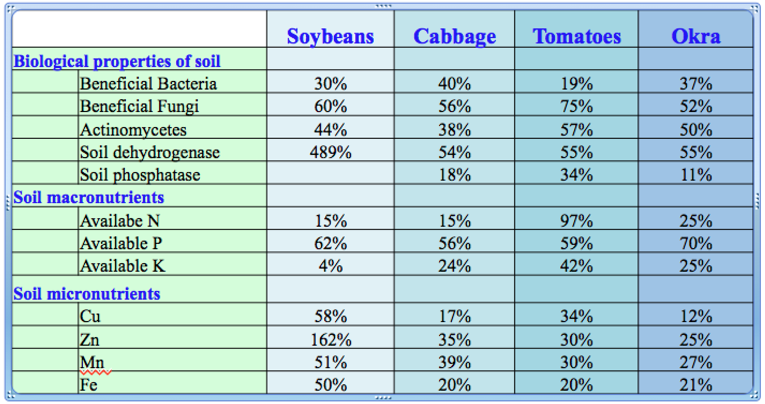
Table 1. Effect of Homa Organic Farming on Soil Parameters
It can be clearly seen that Homa Organic Farming improves soil quality in all the parameters measured. These results were obtained after just one season. It would be worthwhile to continue such a project and see how soil health improves within a longer period, say three years!
This time we concentrated on the effects of Homa Organic Farming on soil quality.
In the next article we will examine how plant growth, yield, quality of the produce were affected, and also see what was the effect on plant health and disease resistance.
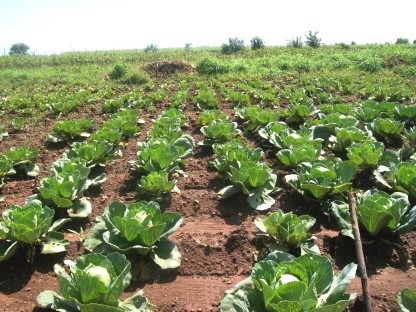
Scientist
By Dr. Ulrich Berk (Germany)
In the last article we summarized four M.Sc. theses from Dharwad University, Karnataka, India, which give ample evidence that with Homa Organic Farming a healthy micro-flora and micro-fauna in soil is created, thus rejuvinating the soil. This is of utmost importance as nowadays conventional farming which uses a wide range of agrochemicals is destroying this micro-flora and micro-fauna, thus leaving behind a soil which is more and more exhausted, no longer a rich living soil. Production comes down and even the supply of food for humanity is at stake, as reports from FAO, the Food and Agriculture Organization of the United Nations state.
A healthy soil is the capital for future generations to grow enough food, it is an investment in the future so to say.
But equally important is production of enough food of good quality to feed the present population. How does Homa Organic Farming help with that? The four M.Sc. theses mentioned above also examined this question. Plants grown were soybeans, tomatoes, cabbage, and okra.
Morphological characteristics and Yield parameters
The following table shows a significant increase in yield parameters.
We compare Homa Organic Farming (including seed treatment and application of Homa Biosol to plants and soil) with farming without Homa as control.

The table shows clearly that both morphological characteristics and yield improved considerably. These results you get when all methods of Homa Organic Farming are followed, including the treatment of seeds, foliar and soil application of Homa Biosol, and also spraying Agnihotra Ash water.
One of the results I want to mention especially: The development of root nodules in soybeans. Such nodules we find in leguminous plants like clovers, alfalfa, lupines, and peanuts besides soybeans.
Nitrogen-fixing bacteria enter the roots of these legumes and multiply, thus forming root nodules.
In these nodules nitrogen gas from the atmosphere (which is easily available there as 78% of our atmosphere is nitrogen) is fixed and made available to plants. When these plants die, the remaining nitrogen remains in the soil, thus improving soil quality and helping growth of plants in the next season. This is of great importance as nitrogen is often the limiting nutrient.
How Homa Organic Farming (including the use of Homa Biosol) helps with the formation of root nodules becomes evident by the following photos.
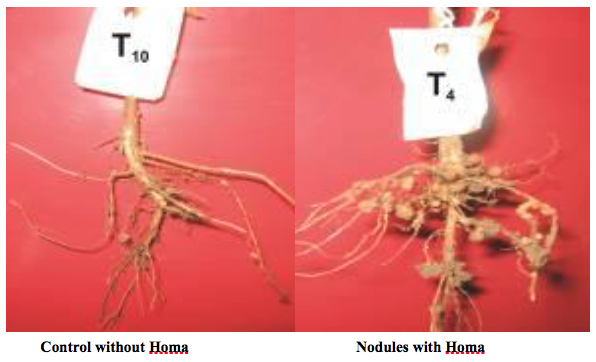
The four M.Sc. theses done at Dharwad University, Karnataka, India, also showed good effects of Homa Organic Farming on quality parameters of the foods grown and regarding reduction of pests and diseases. This will be discussed later.

Scientist
By Dr. Ulrich Berk (Germany)
Vedic Knowledge says that when we perform Agnihotra, a channel is created above the pyramid, going up12 kilometres.
Prana energy – Life Energy – which lies above our atmosphere comes down through this channel. Because of pollution this flow of Prana energy might be blocked otherwise.
When the Prana reaches the Agnihotra pyramid it creates an Aura energy field around all plants in the vicinity which lasts as long as the flame is there.
This makes plants stronger and disease resistant.
Also it is said that Agnihotra brings Nature back to Harmony.
Can these statements be confirmed by modern science?
There are many reports from people who have experienced that pests and diseases got controlled in their gardens and farms. The first systematic studies done by agricultural engineers were done approximately 20 years ago in South America, mainly in Peru. A fungal disease Black Sigatoka affected banana plantations on large scale, destroying up to 90% of the crops. This was especially severe as in South America banana is a staple food for most of the population. Chemical remedies did not work for more than one season – after that the fungal population had become resistant against these fungicides. Many farmers were about to give up their banana plantations, and on one of these farms Homa Organic Farming was started using the resonance technique (in which ten Agnihotra pyramids are energized and arranged in a special configuration so that by resonance a large area up to 80 hectares can be covered). According to reports of government engineers Black Sigatoka infection could be totally eradicated:
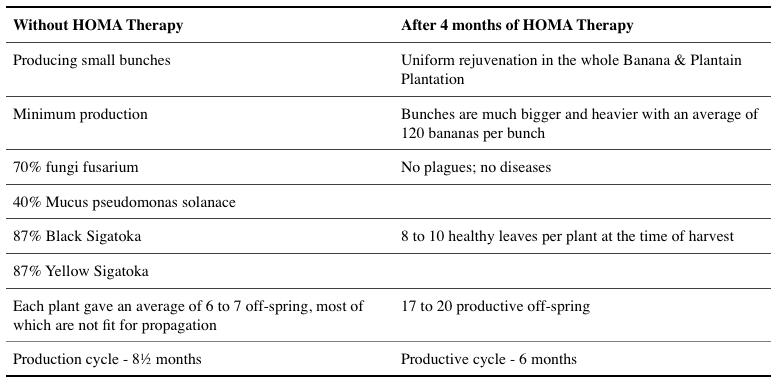
There were some quite astonishing reports of how Homa Organic Farming methods have helped to control diseases and pest infestation. I just want to mention two of those before going to some systematic studies on the subject.
The first report was from Karin Heschl about tomatoes in Jaipur area, India. Farming was done with agrochemicals, and the tomatoes were heavily infested with tomato fruit borer.
All the tomato farms in the village were affected. Heavy doses of chemical insecticide were needed 3 times per week.
In one farm Homa Farming was started. After three months of treatment with Homa Therapy the pest infestation was completely controlled.
The subsequent plantings after beginning Homa Therapy treatment were not infested at all.
Also the yield was double that of the other farmers in the village.
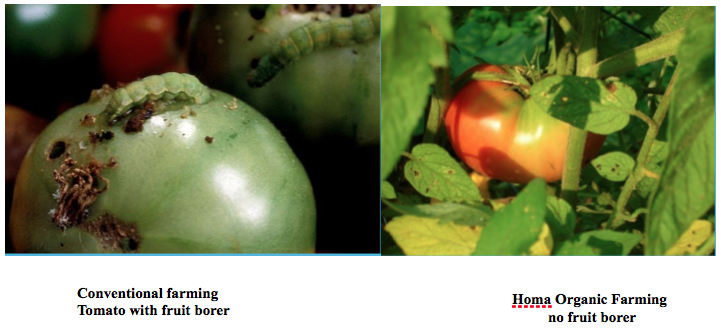
The second report came from Abhay Mutalik Desai, a Homa Organic Farmer from Belgaum area, Karnataka, India. He was growing sugar cane for several years with Homa Farming methods on a 20 acre farm and got good results.
Then in 2005, his plants were surprisingly attacked by woolly aphid. As this should not have happened he checked whether the Homa Farming methods were done properly on the farm and found out that the farm manager had bought ghee from the market which was not pure cow’s ghee. Immediately he got pure cow ghee (and then bought some cows for the farm so that they could produce their own ghee). Immediately after the Homa fires were done with proper ghee two natural predators – Micromus igorotus and Dipha aphidivora – came automatically and controlled the woolly aphid, and again they had lush, green, healthy sugar cane.
Interestingly, the predators started from the area where the woolly aphid had first appeared.
This two examples show how Homa Farming helps to bring Nature back to Harmony.
Later on more systematic research on the effects of Homa Organic Farming on pests and diseases was conducted in India. We already had mentioned four M.Sc. studies done at the Agricultural University in Dharwad, Karnataka, India, and last time we reported the results regarding yield of soy beans, cabbage, tomatoes, and okra. Now let us see the results regarding diseases and pests.
Soy beans
- Decrease in the incidence of rust (16-29%) and insect attack (18-43%) were observed due to different Homa treatments.
- Foliar application of Biosol was found to be effective in the control of rust, pod borer and the control of caterpillar.
Cabbage
- Decrease in the incidence of black rot (29-55%) and black spot of leaf (39-73%), head borer (18-69%), number of diamond back moth larvae per plant (25-64%) and Spodoptera litura larvae per plant (40-62%) were observed due to different homa treatments as compared with organic control not exposed to homa treatment but organic control with homa and conventional control did not differ significantly.
Tomatoes
- Decrease in the incidence of leaf spot (37%) and insect attack (40%) was observed as compared with Gloria Biosol and organic control due to different homa treatments.
Okra
- Decrease incidence of Powdery mildew (19-36%) and Alterneria leaf spot (30-57%), fruit borer (16-38%), and Spodoptera litura larvae per plant (48-68%) were observed due to different homa treatments as compared with conventional control.
These studies show significant reduction in pest infestation and in diseases. The areas of Homa Farming and control were approximately one kilometre apart – which may not be enough to exclude some positive effect of the Homa atmosphere also in the control area. Normally we advise to have these two plots at least three kilometres beeline apart. But even as this distance was not kept they good convincing results.
















